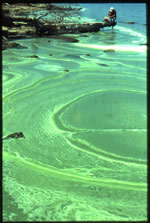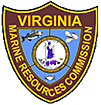HAB’s Hotline: 1-888-238-6154

Algae are microscopic organisms that can be found in coastal waters. They are major producers of oxygen and food for many of the animals that live in these waters.
When environmental conditions are favorable for their development, these cells may multiply rapidly and form high numbers of cells; this is called an algal bloom. A bloom often results in a color change in the water. Algal blooms can be any color, but the most common ones are red or brown. These blooms are referred to as red or brown tides. Most algal blooms are not harmful but some do affect fish and humans, as well as other animals like birds and marine mammals. These are known as Harmful Algal Blooms (HABs).
What are the causes of these blooms?
Blooms can be due to a number of reasons. Two common causes are nutrient enrichment and warm waters. Nutrient enrichment of water, especially phosphates and nitrogen, is often the result of pollution from nonpoint sources and can cause algal blooms. Water temperature has also been related to the occurrence of algal blooms, with unusually warm water being conducive to blooms.
U.S. EPA – You Can Prevent Nutrient Pollution
How are HABs dangerous to fish and humans?
HABs are dangerous to fish because they can deplete oxygen in water. When oxygen levels become too low, fish suffocate and die. Some algae species in blooms produce toxins that can kill fish and cause illness in humans.
How do you get exposed to HAB toxins?
Most illness associated with HAB exposure is the result of consuming toxins that are present in shellfish or finfish. Recreational contact with water (such as swimming) during a bloom may result in illness as well. Some HAB toxins can become airborne during a bloom and people can become ill by inhaling toxins.
Are HABs in Virginia?
Algal blooms do occur in Virginia but blooms that are composed of harmful species of algae are reported rarely in Virginia. Virginia’s coastal waters are monitored for HABs because it is important to be aware of them when they happen to protect public health.
Is it safe to eat fish from fresh bodies of water that have an algae bloom?
In freshwater areas, fish fillets cleaned from fish caught from bloom waters are considered safe for consumption. The guts and fish carcass should be discarded. Fish fillets should be properly cooked and hands and surfaces should be washed thoroughly with soapy water.
Is it safe to eat seafood?
In marine/brackish waters it is generally safe to eat properly cooked seafood. However, consuming properly cooked shellfish that have been harvested from waters with high levels of harmful algae and consuming fish that have lesions or that were caught in an area during an algal bloom can result in illness. Ciguatera Fish Poisoning, Diarrhetic Shellfish Poisoning, Neurotoxin Shellfish Poisoning, Amnesiac Shellfish Poisoning, Paralytic Shellfish Posioning, and Pfiesteria/Estuary-Associated Syndromes are illnesses associated with shellfish/finfish which may effect human consumers depending on where they were harvested.
What are the symptoms of exposure to HAB toxins?
Symptoms vary depending upon the toxin involved. Exposure to different toxins results in different illnesses. Exposure effects in humans to several marine toxins has been well studied and documented, however, the health effects of cyanotoxins (the toxins produced by blue-green algae) are not as well understood.
Marine/Brackish Water Toxin Syndromes:
Ciguatera Fish Poisoning
- Symptoms: diarrhea, vomiting, abdominal pain followed by an onset of nervous system symptoms such as numbness of feet and hands, muscle aches, headaches, reversal of temperature (hot surfaces feel cold and cold feels hot) and dizziness. On rare occasions, paralysis or death can occur.
- Exposure: eating reef fish such as barracuda, snapper, grouper, kingfish, amberjack (jack).
- Location: Caribbean, Florida, Hawaii.
Diarrhetic Shellfish Poisoning
- Symptoms: diarrhea, vomiting, abdominal pain, nausea.
- Exposure: eating shellfish such as molluscs, oysters, and scallops.
- Location: West Coast (California, Oregon), and Northeast Coast (Maine).
Neurotoxic Shellfish Poisoning
- Symptoms: diarrhea, vomiting, numbness. With respiratory exposure, asthma-like symptoms may occur.
- Exposure: eating oysters, fish, and clams. Exposure from breathing in fumes from sea foam during a bloom will also cause symptoms to occur. These HABs usually result in red tides.
- Location: Gulf of Mexico (Texas, Louisiana, Mississippi, Alabama, Florida). Has been associated with fish kills.
Amnesiac Shellfish Poisoning
- Symptoms: diarrhea, vomiting, nausea, short term memory loss, headaches, respiratory difficulties, coma.
- Exposure: scallops, crabs, mussels.
- Location: West Coast (California, Oregon, Washington, Northeast (Maine – Massachusetts), Alaska
Paralytic Shellfish Poisoning
- Symptoms: paralysis, respiratory failure, death. Can be fatal.
- Exposure: oysters, clams, mussels, scallops.
- Location: West Coast (California, Oregon, Washington), Alaska, Northeast (Maine-NewYork).
Pfiesteria and Estuary-Associated Syndrome
- Symptoms: memory loss, headache, fatigue, disorientation, respiratory irritation, skin irritation.
- Exposure: contact with water containing Pfiesteria blooms; inhalation of toxin in special environments.
- Location: Eastern seaboard (Delaware, Maryland, Virginia, North and South Carolina, Florida). Has been associated with fish kills and lesions on fish.
Freshwater/Brackish Water:
Cyanotoxins (human health effects from cyanobacteria toxin exposure are not as well understood as toxins produced by marine/brackish harmful algal species)
- Symptoms: disorientation, ear, nose and respiratory irritation, skin irritation or numbness, nausea and vomiting, fatigue, seizures
- Exposure: contact with water containing a bloom, accidental ingestion of water with bloom, contaminated drinking water, inhalation of aerosolized toxins
- Location: harmful species are found world-wide, including Virginia freshwater bodies and brackish water
If I were to become sick from exposure to HABs, could I transmit a disease to anyone?
The illnesses caused by toxins from HABs are not spread from one person to another.
What is Virginia doing about HABs?
As collaborators of the Virginia HAB Task Force since 1997, the Department of Environmental Quality, the Department of Health, Old Dominion University, Virginia Institute of Marine Science, and Virginia Marine Resources Council, work together to regularly monitor Virginia waters and shellfish growing areas for the presence of HABs and to conduct surveillance for human health effects. This includes surveillance at public beaches and freshwater inland lakes should blooms encroach swimming areas. The Virginia Department of Health’s Office of Drinking Water coordinates with waterworks operators to support voluntary source water protection plans and provides updates on advisory drinking water thresholds. The public will be notified if a HAB that could affect human health is identified.
How do I report an algae bloom?
If you are concerned that you have been exposed to a harmful algal bloom, please see your doctor or call your local health department. Telling your doctor about contact with water may help him/her treat the illness properly.
*NEW* – Click Here to Report a HAB Online
| Questions about health effects and algal blooms, call: | The Virginia Department of Health HAB Hotline: (888) 238-6154 |
| To report discolored water (red, brown, or green) with an odd odor, or dead fish in the water, call: | The Department of Environmental Quality: (757) 518-2000 |
| To report fish with lesions, call: | The Virginia Institute of Marine Science: (804) 684-7000 |
For information on federal policy and guidance, please visit the EPA CyanoHAB website and the CDC HAB-Associated Illness website.





